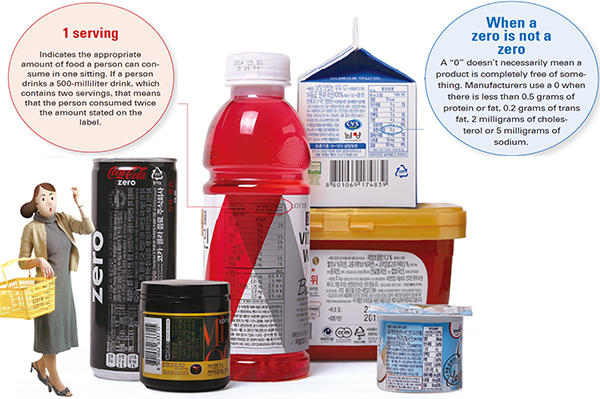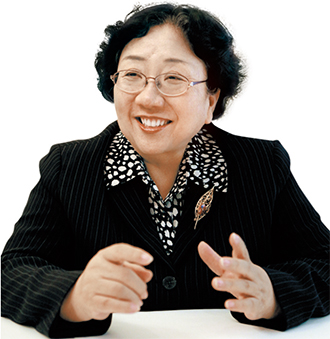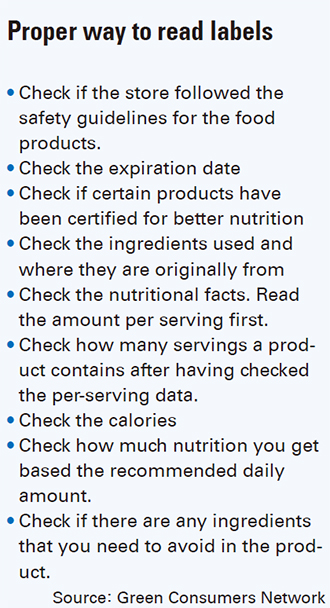When reading the label just isn’t enough


Moon Hyun-kyung
Ascorbyl palmitate, maltodextrin and glycerin esters were written on a certain box of cereal.
Food labeling was introduced so consumers could have more information and make smarter choices about their diets. However, that cause has been compromised as most consumers have no way of understanding many of the chemicals that regularly appear on product packaging.
What is the problem?
A food sanitation law requiring ingredients to be listed was introduced in 1962 and then modified over the years. As of December, products must provide the names of the ingredients used, the date the food was processed and some cautionary information.
Ten government bodies - including the Ministry of Health and Welfare; the Ministry of Environment; the Ministry of Food and Drug Safety; and the Ministry of Agriculture, Food and Rural Affairs - control food labeling through 26 regulations and require 46 types of notifications.
It is a convoluted process, with each governing body making regulations for its own aims, regardless of how much those rules clash with other bodies.
For instance, the Ministry of Environment limits the kinds of packaging that can be used by food producers, limiting the number of layers in an attempt to cut down on waste. This has lead to smaller packages, however, the Ministry of Food and Drug Safety and the Ministry of Agriculture, Food and Rural Affairs want companies to provide more information to consumers.
“One side tells us to minimize the wrapping while the other asks us to put on more information, so it is inevitable that the typeface on the packaging gets smaller and smaller,” said an official in the food industry.

One infamous example was the “traffic lights” labeling system. Just like traffic lights, different food was to be labeled red, yellow and green, with red indicating items with high levels of sugar, carbohydrates, sodium or fat, especially for food that children prefer to eat. It was supposed to be a simple guide to help young people.
However, many worried that this system would lead to children just eating green and yellow foods, thinking they were healthier, when in fact a balanced diet is more complicated than that. For example, fruit juices or cheeses would have gotten flagged as red foods, even though they might contain many vitamins and minerals.
The United Kingdom and European Union had both considered implementing a similar system in the past, but decided against it because they felt it was too distorting.
Another criticism is that the government has not come up with a description of just what constitutes a healthier diet.
“The government does not have a bigger philosophy on how to encourage citizens to be healthy and how to manage food products,” said Professor Moon Hyun-kyung at Dankook University’s Graduate School of Special Education. “So it makes many impromptu decisions each time consumer concerns lead it to introduce new regulations, adding supplementary restrictions.”
With the absence of a big picture or an overarching program, food producers are just told to label everything, rather than focusing on providing the most necessary information that consumers need.
“The labels have become something that no one reads. Consumers in their 50s can’t even read them without a pair of magnifying glasses,” Moon said. “There are so many different types of preservatives and listing all the items included does not really help consumers.”
In addition, companies complain that each change to labelling regulations forces them to change their packaging, costing them money.
“It costs about 2 billion won [$1.9 million] for a food company to change the listing of main ingredients on around 300 products,” said Song Seong-hwa, manager of sanitation education at the Korea Foods Industry Association.
“Such cost will be reflected in the retail price, which means that consumers will eventually pay the price.”
Pedantic jargon confuses customers
So far, consumers have not gotten much use out of product labelling. A survey of 2,000 adults in 2012 by the Korea National Council of Consumer Organizations revealed that more than 23 percent of people only check the expiration date and manufacturing date when buying food products. Others said they just check the price and the place of origin.
Less than 4 percent said that they read any nutritional information on the packaging or whether products are certified as using more nutritional ingredients.
“If you worry about nutrition, you need to check the nutritional table, and if you worry about safety, you need to look for where the main ingredients were made, and whether the product can cause any allergic reaction,” said Jo Yun-mi, co-CEO of Green Consumers Korea.
Consumers need to be aware of what “one serving” means on the label because packages often contain more than one serving. If consumers carelessly read the label, they can easily misunderstand that the entire package only contains the calories, fat and other attributes of one serving.
When the Food Ministry surveyed 2,000 adults last year, only a little more than a half answered that they knew the exact meaning of “one serving.”
It is also crucial to use words that can easily be understood by regular people. Currently, local food authorities require companies to list all the additives used in products, with around 70 turning up fairly frequently.
“Instead of listing meaningless, difficult words, it would be better to mention items over a certain level, and then provide additional information about those few additives,” said an industry expert.
Jo of Green Consumers Korea said there is a global movement to reform the labeling system, including in the United States and Europe, as people pay more attention to their health.
“It is about time for the authorities to come up with ideas to reform the overall system because, as of now, the system is ragged and tattered, as temporary measures have been added whenever new issues rose to the surface,” said Jo.
“We need to diversify the channels experts use to provide information on food products, including mobile applications, QR codes or customer care service, and we need to educate at schools how to read labels correctly and how to use that information.”

Just as the government should strive to have the ingredients in processed foods clearly labelled, consumers also need to educate themselves about what they are putting in their mouths.
To help consumers be more knowledgeable about the information listed on food products, Green Consumers Korea launched a group in 2012 that focuses on food labeling. Its main goal is to educate consumers and to engage agencies related to food labeling.
Experts say that reading labels correctly is incredibly important as it can even help people lose weight.
“There is research that shows that reading food labels the right way can help one lose around four kilograms [8.8 pounds],” said Professor Moon of Dankook University. “The first step to having a healthy diet is reading the labels.”
She cited research done at the University of Santiago de Compostela in Spain, along with the University of Tennessee in the United States and the Norwegian Agricultural Economics Research Institute, as they checked the everyday diet and grocery shopping habits of around 26,000 people. The result indicated that people who read labels meticulously were less likely to be overweight.
“This means that checking the labels has a close relation to a healthy diet,” she said.
To be smart about using information given on a label, she said consumers need to be fully aware of their physical condition.
“After people know well about their bodies and then set a goal to achieve, the contents on the label become more meaningful and useful,” she said.
Although people trying to lose weight focus on calories, they also need to think about the types of food they eat.
“You need to think about the overall nutritional factors with a variety of food products,” Moon continued, “and use the contents on the food labels so you can balance your eating habits.”
For people who suffer from any chronic diseases that impact their everyday lives, the nutritional information marked on the label of processed foods is the key.
One may be easily tricked into believing that some products have no fat or cholesterol, or that they have particularly high calcium. However, even the labels can be misleading because the government does not have guidelines about how the information should be displayed.
For instance, many companies claim that they did not add any additional sweeteners to their products. That may be true, but that doesn’t make an item entirely sugar-free. The original ingredient used to make the snack may already contain sugar, so the product may be sweet, even without any added sugar.
“If you are afraid of contracting heart disease or getting a stroke, you need to check the amount of cholesterol or trans fat, along with sugars and saturated fat,” said Professor Kim Kyung-su of Seoul St. Mary’s Hospital.
“If you are obese, you need to check the overall calorie and fat amounts, while people with high blood pressure need to check the sodium amount.”
Companies often use the trick of saying they use whole grains or nuts, which are considered relatively healthier than processed grains, but they might have just used a little bit of nuts and whole grains, perhaps only 1 or 2 percent, in addition to the usual processed grains.
How to make the right choice
One healthy step is to look for a Haccp certification - pronounced “HAS-sip,” it stands for Hazard Analysis and Crucial Control Points - a system for ensuring food safety that was developed in the United States and then adopted by the Korea Food and Drug Administration. Only the products that pass the Haccp process can get the certificate.
“Any products that the Food Ministry approves of can have a rectangular-shaped green logo on the packaging,” said manager Lee Gyeong-gae at the Korea Agency of Education, Promotion and Information Service in the Ministry of Food, Agriculture, Forestry and Fisheries.
Some labels also include the quality of the ingredients, especially its meat and grains.
“Rice tastes better when it has less protein,” said Professor Kim Jung-won at Seoul National University of Education’s Department of Science and Technology Education for Life.
“Also, rice tastes better when it was harvested recently and when it was cooked within two weeks after being hulled.”
Meat products including pork and beef are graded based on the amount of fat, the color of the meat and other criteria, but those are just supplementary information and cannot guarantee taste or nutrition.
For snacks that children enjoy often, it is smarter for parents to choose whichever contains lesser amounts of trans fats, sodium and sugar, as many snack foods are high in calories and can lead to obesity.
Softer biscuits tend to contain more fat than harder ones. If it is hard to make a decision on what items to buy based on the nutritional information, then try purchasing products that have been certified by the government as passing quality standards, especially for children.
BY PARK TAE-HEE [summerlee@joongang.co.kr]










with the Korea JoongAng Daily
To write comments, please log in to one of the accounts.
Standards Board Policy (0/250자)